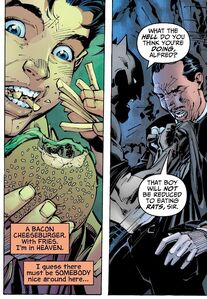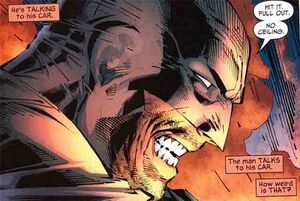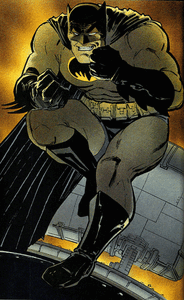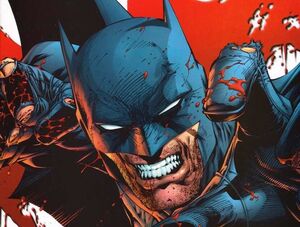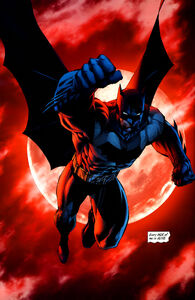No edit summary |
(Adding categories) |
||
| Line 135: | Line 135: | ||
[[Category:Opportunists]] |
[[Category:Opportunists]] |
||
[[Category:Remorseful]] |
[[Category:Remorseful]] |
||
| + | [[Category:Perverts]] |
||
| + | [[Category:Murderer]] |
||
Revision as of 12:21, 25 June 2019
| This article's content is marked as Mature The page contains mature content that may include coarse language, sexual references, and/or graphic violent images which may be disturbing to some. Mature pages are recommended for those who are 18 years of age and older. If you are 18 years or older or are comfortable with graphic material, you are free to view this page. Otherwise, you should close this page and view another page. |
| “ | What, are you dense? Are you retarded or something? Who the hell do you think I am? I'm the goddamn Batman! |
„ |
| ~ Batman in response to Dick Grayson questioning his orders. |
In his earlier works like Batman: The Dark Knight Returns, Batman: Year One, Spawn/Batman and later ones like The Dark Knight III: The Master Race and Dark Knight Returns: The Last Crusade, Frank Miller's incarnation of Batman of his Dark Knight Universe managed to well-maintain his classical heroic qualities, even with the darker nature of the narratives. However, in the later stories The Dark Knight Strikes Again and All-Star Batman and Robin, the Boy Wonder, Miller's incarnation of Batman is a sociopathic "hero" that is universally hated by both critics and readers alike.
In the animated adaptations of Year One and The Dark Knight Returns respectively, Miller's Batman was voiced by Ben Mackenzie and Peter Weller respectively.
History
All-Star Batman and Robin, the Boy Wonder
In what is said to be the canonical start of all of Miller's Batman works following Batman: Year One, Bruce Wayne first appears to watch the performance of Dick Grayson, age 12, and his family with a particularly creepy focus on Dick. When Grayson's parents are murdered, Batman abducts Dick against his will, saying he's "drafted into a war", and takes him into the Batmobile. When the police give chase, Batman violently rams the Batmobile through their cars, splitting one in half. He posits on how the police is corrupt and smacks Dick when the child understandably cries out of fear. Although Batman briefly questions his actions, he nevertheless keeps Dick as a prisoner. At the Batcave, Batman shows a childlike annoyance in Dick's lack of wonder at the sight of the Batcave and leaves him there. When asked what he should do, Batman simply tells Dick to survive on his own and eat at the rats that show up. Alfred becomes concerned for the child and gives him food and warm clothes, which drives Batman into a rage and he almost beats Alfred to a pulp for "interfering".
They eventually capture the killer of Dick's parents and find that he had been hired by The Joker, dumping him in a river. During one of their rounds, Batman lures Green Lantern Hal Jordan and beats up the superhero with no provocation in a room full of yellow, which he cannot use his ring's powers against. Jordan argues against the cruel and unsavory methods Batman employs, only to be mocked by Batman and urged into a fight when Robin steals his ring. However, Batman shows an odd semblance of humanity when he stops Dick from violently murdering Hal and later shares a moment of mutual grief in a graveyard. Nevertheless, he still retains Grayson as Robin.
This is also the incarnation of Batman that spawned the infamous "I'm the Goddamn Batman!" meme as seen in the page quote, further demonstrating how radically different this incarnation of Batman is.
The Dark Knight Strikes Again
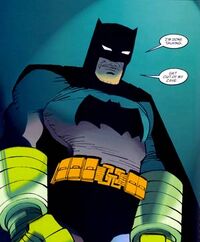
DK2 Batman, after defeating Superman.
In the years following the events of The Dark Knight Returns, Batman returns to action to enact against the tyranny of Lex Luthor. However, his actions are more in line with those of a terrorist rather than a superhero. In his instance of attacking and taking down Luthor, he does not stop the villain right there, instead preferring to rely on terrorist acts (most notably mutilating Luthor's face with a massive "Z"). The graphic novel is also known for yet another brutal beating of Superman with empowered gloves. While Superman is forced by Luthor and Brainiac to work for them on the threat of destroying the bottled city of Kandor, Batman shows very little mercy to his former ally, instead using the opportunity to just beat up Superman while hypocritically declaring that those lacking any empowerment are better.
He also encourages a group of young women dressed as superheroes called The Superchix to rebel, resulting in their deaths for a completely pointless act, likely his Moral Event Horizon-crossing act. He also pulls another MEH-worthy action in having the heroes hold back when many civilians are murdered and injured by a Brainiac-conjured monster. While he does recognize it as a trap, he still prefers to let millions die just to ensure his plan works, an action very uncharacteristic of the usual Batman. When he finally gets to Luthor, Batman allows himself to be captured and tortured, only to set up Luthor to be caught by Hawkman and Hawkgirl's son. In another very uncharacteristic act for Batman, he encourages their son to get revenge on Luthor, leading to the villain's horrific death. When Flash questions this action, Batman silences him.
At the end, he goes to rescue his new Robin-turned-Catgirl Carrie from a superhero-killing Joker-esque shapeshifter that is revealed to be none other than Dick Grayson. Grayson reveals past affections for Batman, to which Batman taunts with disturbingly homophobic slurs while also noting that he was useless and pathetic (which definitely takes a darker overtone when one considers All-Star Batman and Robin, the Boy Wonder). Batman ultimately kills Grayson by knocking him into a volcanic center below the Bat Cave after being saved by Superman. By taking the previous narrative into consideration, this is the tragic and disturbing result of Batman's abuse of Grayson, which might have even been sexual as well as physical and emotional. Nevertheless, Batman once again shows a somewhat human side by his apparent care for Carrie, although some have interpreted this as implying creepy wife husbandry at work - although Carrie shows none of the resentment towards Batman as Grayson does here.
Batman also presents another disturbing side to his character in the arc involving Superman and his daughter, who questions why they, as Kryptonians, should just not use their power to rule over those on Earth. Superman argues that such a thing would be wrong, until Batman steps in and actually mocks Superman for not taking advantage of his powers to accomplish such a goal.
Personality
This version of Batman is pretty much the complete opposite of any trait associated with the classic Batman; whereas the original Batman adhered to a strict moral code, this Batman is a violent sociopath. It is clear through the story that this Batman is mentally sick, as he tends to overreact to nearly everything with extreme violence, even the smallest sign of provocation. He exhibits a childish personality, getting mad at Dick Grayson because the child didn't think the batcave was "cool" and is completely abusive towards everyone who crosses his way, even his butler, Alfred, and Black Canary, whom Batman forms an abusive relationship with (ironically, as Black Canary was despicted as hating men due to them being extremely disrespectful to her for being an attractive woman). He also presents a disturbed obsession with Dick, which is shown by the fact that he spied on the kid for months before his parents were murdered and immediately kidnapped the boy to force him to fight crime without a care for the boy's opinion. He lacks empathy and codes, as he brutally killed tons of criminals he encountered, and also had no problem forcing the 12 year old Dick to eat rats and bats to survive alone in a cave, as well as tricking and brutally beating up Green Lantern just because the hero didn't agree with his methods. He was willing to leave millions of innocent people to die just to complete his plans and taking no responsibilities for his acts, as he repeatedly berates Dick for coming into his life and making his job more difficult, while ignoring that he was the one who abducted the boy against his will to fight crime.
However, this Batman isn't completely lacking in morals, as he stopped an enraged Dick Grayson from killing the beaten and defenseless Green Lantern, as well showing some signs of regret for his treatment of Grayson; he's shown to care about Carrie and is not seen as abusive towards her as he was towards Dick. As Batman is already a mature man in his mid-50s by the time Carie takes the mantle of Robin, it might be possible that within the years, he may have softened and become a better crimefighting crusader than he was when he started, yet the Lex Luthor/Dick Grayson incident causes him to temporarily revert back to his younger self. However, even so, he expressed remorse by having to get Grayson killed, possibly implying that he regretted his previous treatment towards him and that he felt a fatherly bond towards him as in Carrie's case (having been confirmed by Frank Miller that as Carrie sees him as the paternal figure she never had, Batman most likely sees her as the daugther he never had as well).
Gallery
Trivia
- Frank Miller's Dark Knight Universe series is considered non-canon to the mainstream Batman continuity, with the exception of Year One, which is commonly accepted as the origin story of Batman.
- In the original The Dark Knight Returns, Bruce Wayne retires following the death of Jason Todd, only to be brought back into acting as Batman years later. While this incarnation is indeed an anti-hero (and definitely far more heroic than either of the other works mentioned here), it also reflects his returning dip into insanity. If the Frank Miller chronology is accurate, it can be assumed that he was the sociopathic self seen within All-Star Batman & Robin before realizing his own insanity and retiring. However, this return to Batman led to his eventual insanity.
- While mostly heroic, there is still the major battle between Batman and Superman who acts on behalf of the government after the Joker finishes himself off. In the brutal fight to follow, Batman fakes his own death. However, he is also shown instigating riots in the streets against the Mutants by stirring the "Sons of Batman" (or the S.O.B.s), who demonstrate a darkly anti-heroic vigilantism (such as S.O.B.s murdering would-be robbers, rather than arresting them as Batman would).
- Originally, the ending of The Dark Knight Returns had the Gotham City Police Department officers led by Ellen Yindel gun down Batman. However, Frank Miller ultimately changed the ending to symbolize that Bruce Wayne has died but the Dark Knight lives on. Had Miller mantained the original ending, this wouldn't have only prevented any sequels to be made, but most likely would have kept this Batman as a firm hero rather than a sociopathic anti-hero as later depicted.
- It is generally theorized that both of these characterizations are a response and ridicule to the Dark Age incarnation of Batman seen in The Dark Knight Returns. However, in both instances, they only further cement the character as a sociopath.
- A really disturbing implication regarding Miller's Batman is that he was involved in an incestuous relationship with and/or was molested by at least one of his parents, which might have corrupted him later on. His mother is the likely candidate given Batman's remarks regarding his mother's "bleeding breast", although this could just suggest that he has an Oedipus complex o that the young Bruce may have accidentally saw his mother's breasts, perhaps entering in his parents' room when he wasn't supposed to do.
- In his reviews of the issues of All-Star Batman and Robin, the Boy Wonder, Linkara theorises at one point that this isn't Batman, but instead a crazy hobo named Steve who managed to steal the Batsuit and began thinking that he was actually Batman. Thus, Linkara's name for the character "Crazy Steve" has become a fan nickname for the ASBRtBW incarnation, with the series being referred to as "All-Star Crazy Steve and Dick Grayson, Age 12".
- The DCEU incarnation of Batman is primarily based on Frank Miller's Batman, in terms of costume design, his aggressive nature and lethal methods of combat and interrogation. However, unlike this Batman, the DCEU Batman is a far more caring and respectful person who only resorts to brutal violence due to the loss of Jason Todd, which is far more akin to the version of the character in The Dark Knight Returns as opposed to later stories.
- Despite this version being hated, the popular nickname "The Goddamn Batman" originated within this version of Batman.
- This version of Batman might be Frank Miller's more realistic depiction of a incredibly skilled vigilante using vengeance to fight crime, similar to Alan Moore's Rorschach.



